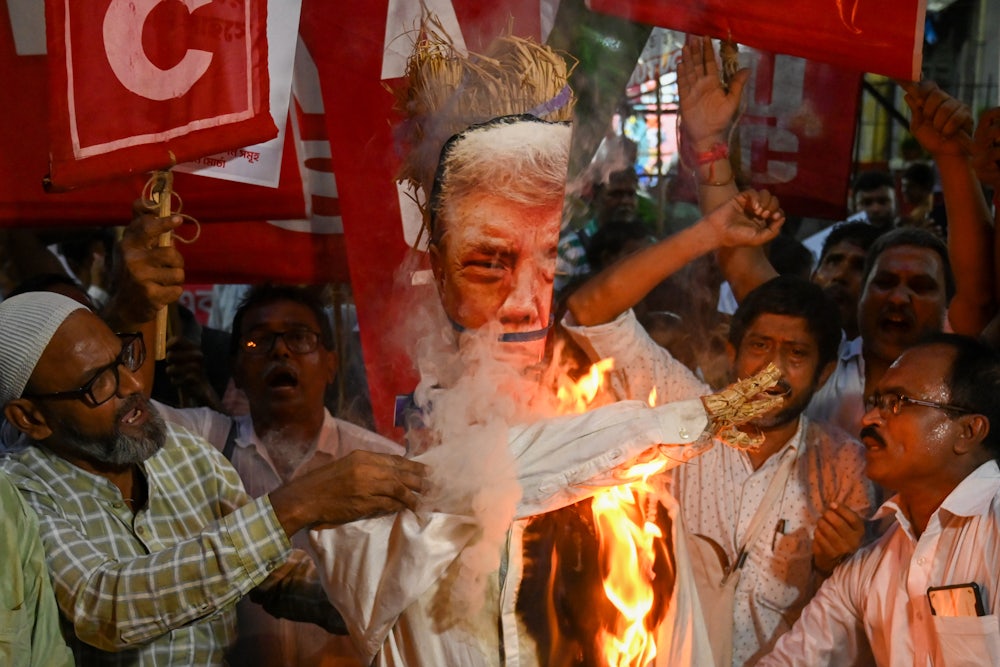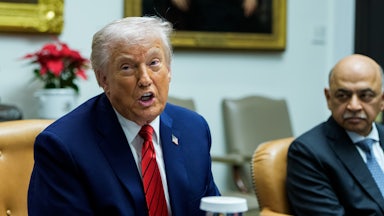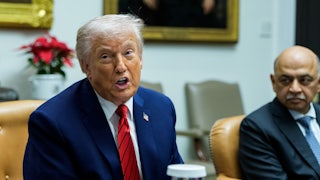Imagine you are at the pharmacy counter, grabbing your daily statin or antidepressant, those affordable generics that keep millions of Americans going. You probably don’t realize that almost half of all generic medicines taken in the United States come from India alone. Medicines from Indian companies save America billions in healthcare costs—$219 billion in 2022, according to the IQVIA Institute for Human Data Science.
But with Donald Trump’s recent hike to tariffs on Indian imports, punishing Delhi for buying Russian oil, that lifeline could snap and many Americans may have to brace for steeper medical bills. A lengthy report in The New York Times Wednesday referred to the 50 percent tariff schedule as “extraordinary.” This isn’t just about higher bills. It’s a strategic blunder fracturing the U.S.-India partnership at a time when Americans need it most. India is America’s key ally in the Quad to counter China, but these tariffs are pushing it toward Beijing and Moscow.
Trump imposed the tariff just after midnight on Wednesday in Washington, upending a decades-long push by the United States to forge closer relations with India. India is one of America’s most important strategic partners in Asia. India and the United States are brought together by mutual interests and common values. But these tariffs are now among the highest the United States charges across all countries.
America has strategically deepened relations with India in recent years. But this move risks bringing the relationship to its lowest point. Trump risks alienating a crucial partner by hitting a significant portion of India’s export economy to the United States, which is valued at nearly $87 billion.
India supplies a huge amount of textiles, automotive parts, and even software services to the American market. But pharmaceuticals stand out because they directly affect health and the economic conditions of people. Generic drugs from India are cheaper versions of brand-name medications. With India providing nearly half of generic prescriptions in the U.S., Americans could face higher prices and more shortages of critical drugs due to the disruptive levies on lifesaving medications. That’s the kind of real pain these tariffs could bring.
India imports around two million barrels of crude oil per day from Russia, making it the second largest purchaser of Russian oil, according to a report. India and Russia have been supporting each other for decades. When Russia invaded Ukraine in 2022, Western countries imposed sanctions on Russia, which drove down the price of Russian crude. India turned to purchasing Russian oil sold at a discount. India could lose as much as a full percentage point of its GDP growth due to the tariff. This would be a significant blow for India. It may result in fewer investments, slower job creation, and more general instability that affects international markets.
In addition, the tariffs seem selective. China, the other major buyer of Russian oil, has faced no equivalent penalties. Why pick on India when China buys even more Russian oil and poses a bigger strategic threat? This double standard makes the U.S. look inconsistent and weakens its moral ground in international communities.
Trump has placed Prime Minister Narendra Modi in a challenging position: Giving in to American pressures could cause domestic backlash because consumers would be hit by higher oil prices, and rebuffing them would result in high tariffs. “India will never compromise on the interests of its farmers, dairy farmers, and fishermen,” Modi said during a speech at an agricultural conference in New Delhi. India doesn’t want to appear weak, which is reflected in his defiance. It will continue to assert that its foreign policy is guided by its national security.
Tariffs aren’t the only front on which Trump has put the U.S.-India relationship at risk. India and Pakistan had a brief four-day conflict in May. When it ended, Trump took credit for brokering the ceasefire. India denied this, insisting it resulted solely from bilateral dialogue. Shortly after doing that, Trump hosted Pakistan’s army chief, Asim Munir, for lunch at the White House. Such missteps, combined with tariffs, increase the risk of pushing India toward China and Russia. It’s like America is handing India reasons to rethink its alliances, at a moment when unity against common threats is crucial.
The Trump administration must recognize that coercion is counterproductive. India’s strategic autonomy cannot be dictated by tariffs. A diplomatic reset is essential, one that prioritizes dialogue over punishment. The United States could offer targeted exemptions for India’s key exports, like pharmaceuticals, in exchange for gradual reductions in Russian oil imports. This would allow Modi to save face domestically while aligning with U.S. goals. Washington should recommit to the Quad, hosting its planned summit in India this year to signal enduring partnership. Strengthening defense and technology cooperation, already robust through initiatives, could rebuild trust.
Trump needs to go beyond just exemptions. For example, joint ventures in clean energy could help India diversify away from Russian oil. Sharing technology for solar or wind power would benefit both nations, reducing dependence on fossil fuels and creating jobs. Similarly, expanding educational exchanges and people-to-people ties could foster goodwill that’s harder to break with policy swings.
Finally, Trump must temper his rhetoric. Publicly taunting India as a “dead economy” or claiming credit for its diplomatic achievements alienates a proud nation. A quieter, more respectful approach, acknowledging India’s global aspirations, would go further in securing cooperation. The United States could also leverage its influence to support India’s bid for a permanent U.N. Security Council seat. That would reinforce New Delhi’s stake in the U.S.-led order and show we’re invested in India’s rise, not just using it as a counterweight.
Some in Washington see the tariffs as a negotiating tactic, not a permanent rupture, aimed at forcing India to diversify its energy sources. Yet this view underestimates the long-term damage. Alienating India risks not only economic ties, but also its role as a strategic partner in containing China’s ambitions, from the South China Sea to the Indian Ocean. If India drifts closer to BRICS nations, it could strengthen a bloc that challenges Western dominance in trade, finance, and technology.
The United States cannot afford to lose India. For India, the costs are high; its global ambitions rely on American support, and a drift toward Beijing or Moscow would undermine its superpower aspirations. Trump’s tariffs may aim to weaken Russia, but they risk a far greater loss: a fractured partnership that could reshape the global order in China’s favor. India and the United States should put effort to reset ties despite tensions with creative diplomacy. Trump must act swiftly to repair this rift, prioritizing diplomacy.
A strong U.S.-India bond isn’t just about geopolitics; it’s about shared prosperity. Indian innovation in IT and pharmaceuticals complements American strengths. But if tariffs force India to pivot, the supply chains could shift to less reliable partners, hurting U.S. consumers. It’s high time for smarter engagement that builds bridges, not walls.






